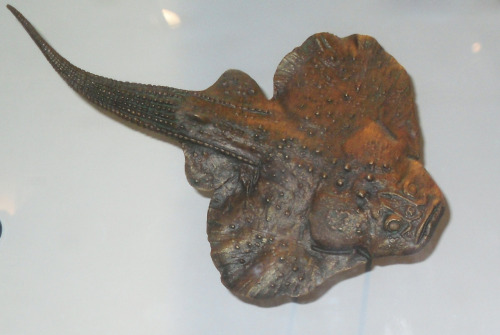Gemuendina Fossil and model both on display at the American Museum of Natural History, NYCModel crea
Gemuendina Fossil and model both on display at the American Museum of Natural History, NYCModel created by Louis FerraglioWhen: Early Devonian (~410 to 392 million years ago)Where: Germany What: Gemuendina is an odd little placoderm fish. It is known only from the early Devonian of Germany, from deposits that have been reconstructed to represent areas with anoxic bottom waters. Anoxic means ‘lack of oxygen’, so there was no oxygen in the sediments where the dead or dying fish fell, and thus scavengers and decomposing organisms could not disturb the remains. Specimens of Gemuendina have only been preserved in such conditions because their armor was not a solid shield, as seen in some other placoderms, but rather a series of unfused relatively thin bony plates. This placoderm bears a close resemblance to a ray, with its flat body and series of horizontal fins. This is another excellent example of convergent evolution. Unlike rays, however, the eyes of Gemuendina were on the top of its head, not the side, and its nostrils were on top as well, not on its ventral (under) surface.Within Placodermi Gemuendina falls into the clade Rhenanida. This group shares the characters of a ray-like body and the lose series of unfused plates that covered their flat bodies. While the ray-like body is a shared derived feature that unites the group, the seires of individual plates is likely a retained primitive feature that was also found in the first placoderms, which gave rise to all of the rest, including massive forms such as Dunkleosteus. Gemuendina is one of the earliest well-known members of the clade, but isolated plates from tens of millions of years earlier in the Silurian period may represent the true first rhenanids. Though the fossils are rare and fragmentary, rhenanids swam throughout the Devonian waters all over the world. -- source link
Tumblr Blog : dailyfossil.tumblr.com
#devonian#europe#germany#paleontology#geology#paleozoic#fossil#biology#evolution#science#placoderm

